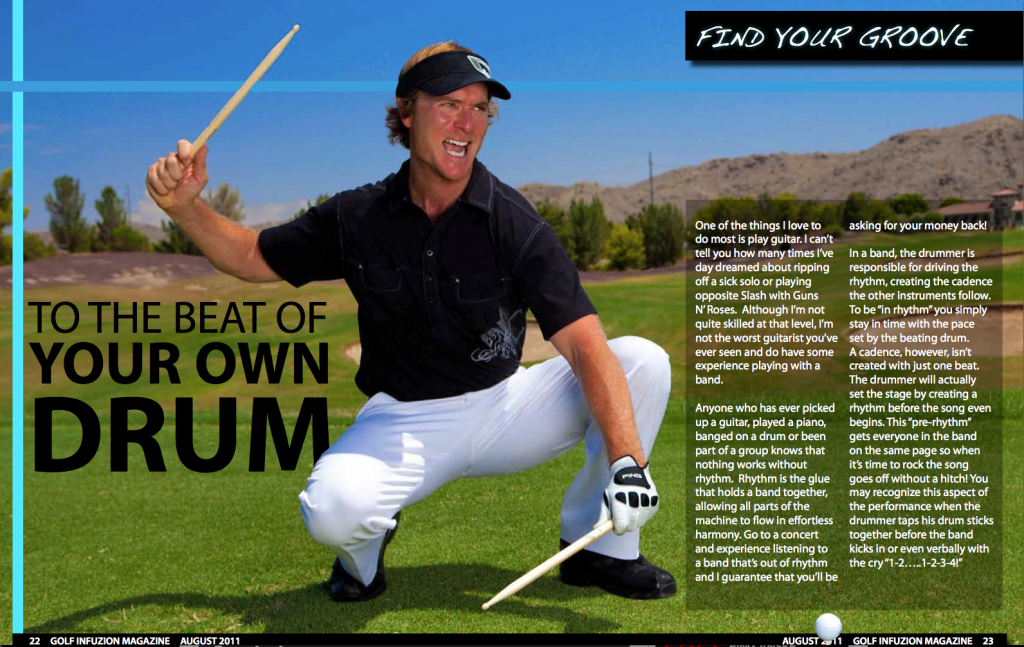Find Your Groove!
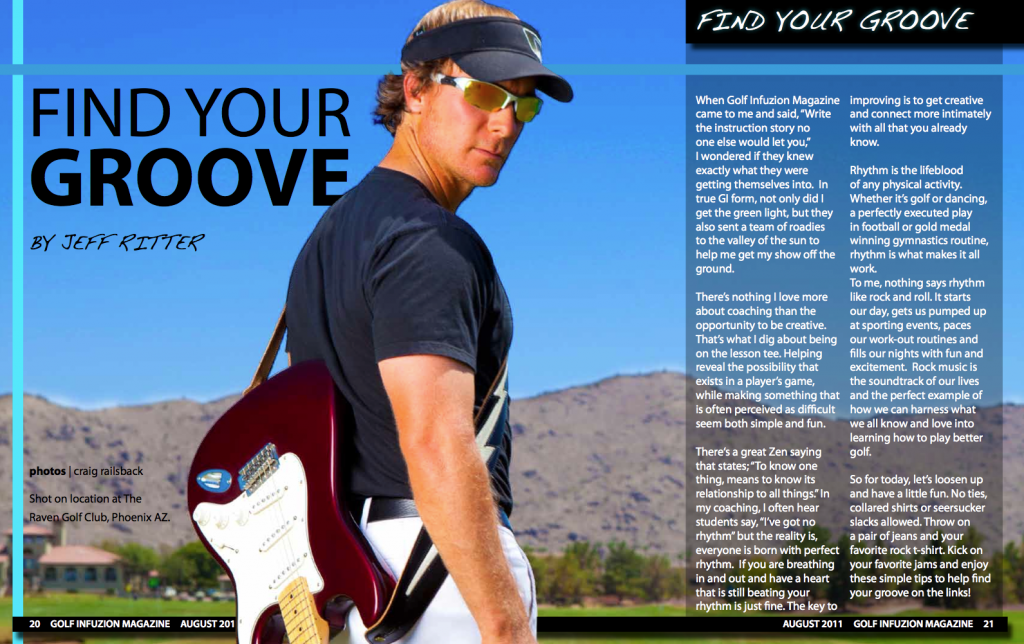
When Golf Infuzion Magazine came to me and said, “Write the instruction story no one else would let you,” I wondered if they knew exactly what they were getting themselves into. In true GI form, not only did I get the green light, but they also sent a team of roadies to the valley of the sun to help me get my show off the ground.
There’s nothing I love more about coaching than the opportunity to be creative. That’s what I dig about being on the lesson tee. Helping reveal the possibility that exists in a player’s game, while making something that is often perceived as difficult seem both simple and fun.
There‘s a great Zen saying that states; “To know one thing, means to know its relationship to all things.” In my coaching, I often hear students say, “I’ve got no rhythm” but the reality is, everyone is born with perfect rhythm. If you are breathing in and out and have a heart that is still beating your rhythm is just fine. The key to improving is to get creative and connect more intimately with all that you already know.
Rhythm is the lifeblood of any physical activity. Whether it’s golf or dancing, a perfectly executed play in football or gold medal winning gymnastics routine, rhythm is what makes it all work.
To me, nothing says rhythm like rock and roll. It starts our day, gets us pumped up at sporting events, paces our work-out routines and fills our nights with fun and excitement. Rock music is the soundtrack of our lives and the perfect example of how we can harness what we all know and love into learning how to play better golf.
So for today, let’s loosen up and have a little fun. No ties, collared shirts or seersucker slacks allowed. Throw on a pair of jeans and your favorite rock t-shirt. Kick on your favorite jams and enjoy these simple tips to help find your groove on the links!
In a band, the drummer is responsible for driving the rhythm, creating the cadence the other instruments follow. To be “in rhythm” you simply stay in time with the pace set by the beating drum. A cadence, however, isn’t created with just one beat. The drummer will actually set the stage by creating a rhythm before the song even begins. This “pre-rhythm” gets everyone in the band on the same page so when it’s time to rock the song goes off without a hitch! You may recognize this aspect of the performance when the drummer taps his drum sticks together before the band kicks in or even verbally with the cry “1-2…..1-2-3-4!”
To play really great golf you have to get your swing started on time and in rhythm. In my experience, the best way to do that is by moving to the beat of your own drum. Just like the drummer, get into your groove by internalizing and feeling a cadence. Start by looking at the target and creating one clockwise “waggle.” Internally verbalize this movement as “One.” Keep focused on the target and replicate the same waggle, this time internally verbalizing the number “Two.” Turn your focus to the golf ball and make a third waggle, this time verbalizing this movement as “One” again. Set the club head behind the ball as “Two.” Swing back “Three” and swing through “Four.” Put it all together and you get 1-2…1-2-3-4. As you internally verbalize each movement you’ll feel a cadence where there’s an equal amount of time separating each movement. Once your verbal cadence and physical movement match perfectly, your club head will move away from the ball on time, tension free and in perfect rhythm!
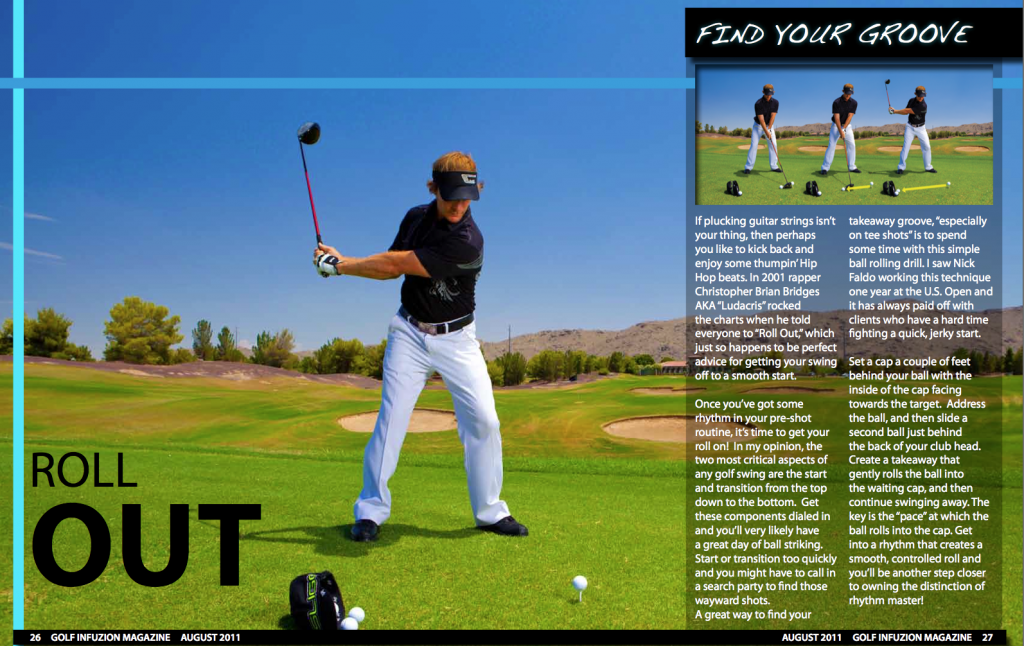
Roll Out
If plucking guitar strings isn’t your thing, then perhaps you like to kick back and enjoy some thumpin’ Hip Hop beats. In 2001 rapper Christopher Brian Bridges AKA “Ludacris” rocked the charts when he told everyone to “Roll Out,” which just so happens to be perfect advice for getting your swing off to a smooth start.
Once you’ve got some rhythm in your pre-shot routine, it’s time to get your roll on! In my opinion, the two most critical aspects of any golf swing are the start and transition from the top down to the bottom. Get these components dialed in and you’ll very likely have a great day of ball striking. Start or transition too quickly and you might have to call in a search party to find those wayward shots.
A great way to find your takeaway groove, “especially on tee shots” is to spend some time with this simple ball rolling drill. I saw Nick Faldo working this technique one year at the U.S. Open and it has always paid off with clients who have a hard time fighting a quick, jerky start.
Set a cap a couple of feet behind your ball with the inside of the cap facing towards the target. Address the ball, and then slide a second ball just behind the back of your club head. Create a takeaway that gently rolls the ball into the waiting cap, and then continue swinging away. The key is the “pace” at which the ball rolls into the cap. Get into a rhythm that creates a smooth, controlled roll and you’ll be another step closer to owning the distinction of rhythm master!
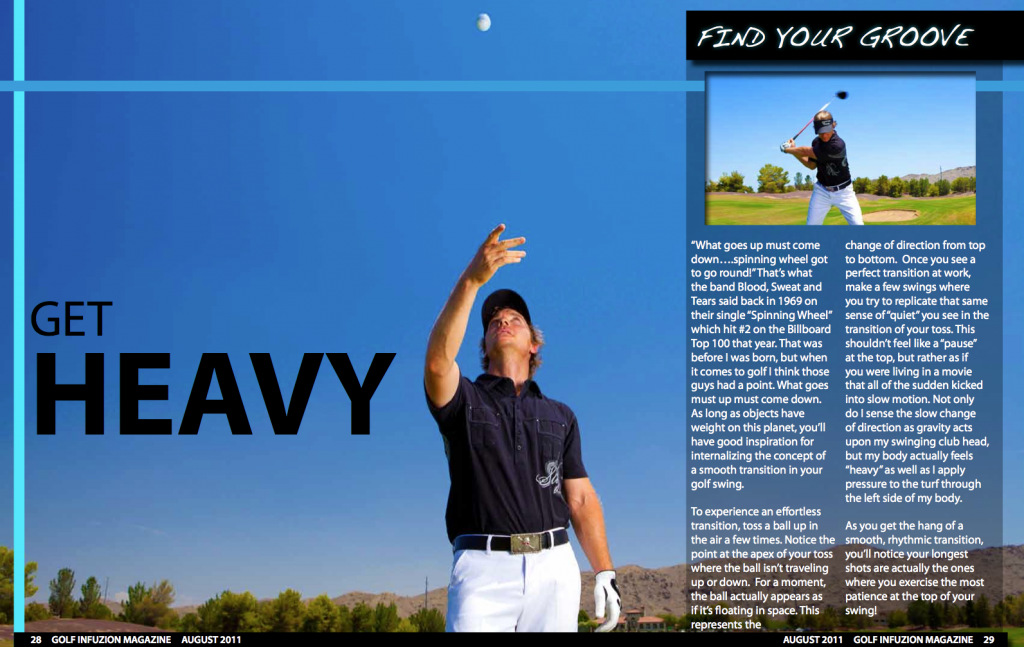
Get Heavy
“What goes up must come down….spinning wheel got to go round!” That’s what the band Blood, Sweat and Tears said back in 1969 on their single “Spinning Wheel” which hit #2 on the Billboard Top 100 that year. That was before I was born, but when it comes to golf I think those guys had a point. What goes must up must come down. As long as objects have weight on this planet, you’ll have good inspiration for internalizing the concept of a smooth transition in your golf swing.
To experience an effortless transition, toss a ball up in the air a few times. Notice the point at the apex of your toss where the ball isn’t traveling up or down. For a moment, the ball actually appears as if it’s floating in space. This represents the change of direction from top to bottom. Once you see a perfect transition at work, make a few swings where you try to replicate that same sense of “quiet” you see in the transition of your toss. This shouldn’t feel like a “pause” at the top, but rather as if you were living in a movie that all of the sudden kicked into slow motion. Not only do I sense the slow change of direction as gravity acts upon my swinging club head, but my body actually feels “heavy” as well as I apply pressure to the turf through the left side of my body.
As you get the hang of a smooth, rhythmic transition, you’ll notice your longest shots are actually the ones where you exercise the most patience at the top of your swing!
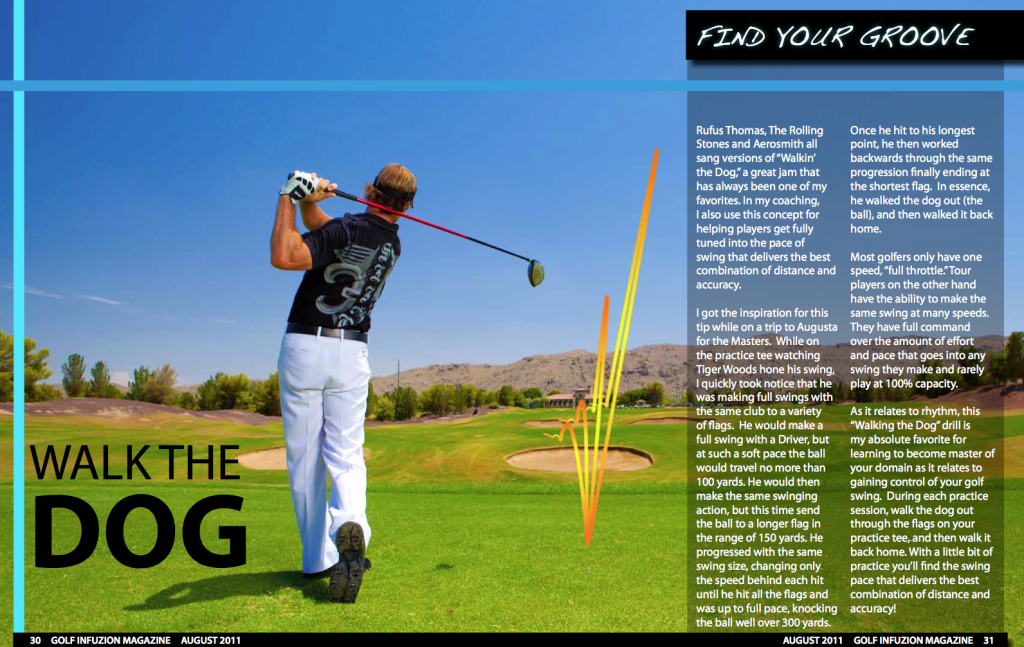
Walk the Dog
Rufus Thomas, The Rolling Stones and Aerosmith all sang versions of “Walkin’ the Dog,” a great jam that has always been one of my favorites. In my coaching, I also use this concept for helping players get fully tuned into the pace of swing that delivers the best combination of distance and accuracy.
I got the inspiration for this tip while on a trip to Augusta for the Masters. While on the practice tee watching Tiger Woods hone his swing, I quickly took notice that he was making full swings with the same club to a variety of flags. He would make a full swing with a Driver, but at such a soft pace the ball would travel no more than 100 yards. He would then make the same swinging action, but this time send the ball to a longer flag in the range of 150 yards. He progressed with the same swing size, changing only the speed behind each hit until he hit all the flags and was up to full pace, knocking the ball well over 300 yards. Once he hit to his longest point, he then worked backwards through the same progression finally ending at the shortest flag. In essence, he walked the dog out (the ball), and then walked it back home.
Most golfers only have one speed, “full throttle.” Tour players on the other hand have the ability to make the same swing at many speeds. They have full command over the amount of effort and pace that goes into any swing they make and rarely play at 100% capacity.
As it relates to rhythm, this “Walking the Dog” drill is my absolute favorite for learning to become master of your domain as it relates to gaining control of your golf swing. During each practice session, walk the dog out through the flags on your practice tee, and then walk it back home. With a little bit of practice you’ll find the swing pace that delivers the best combination of distance and accuracy!
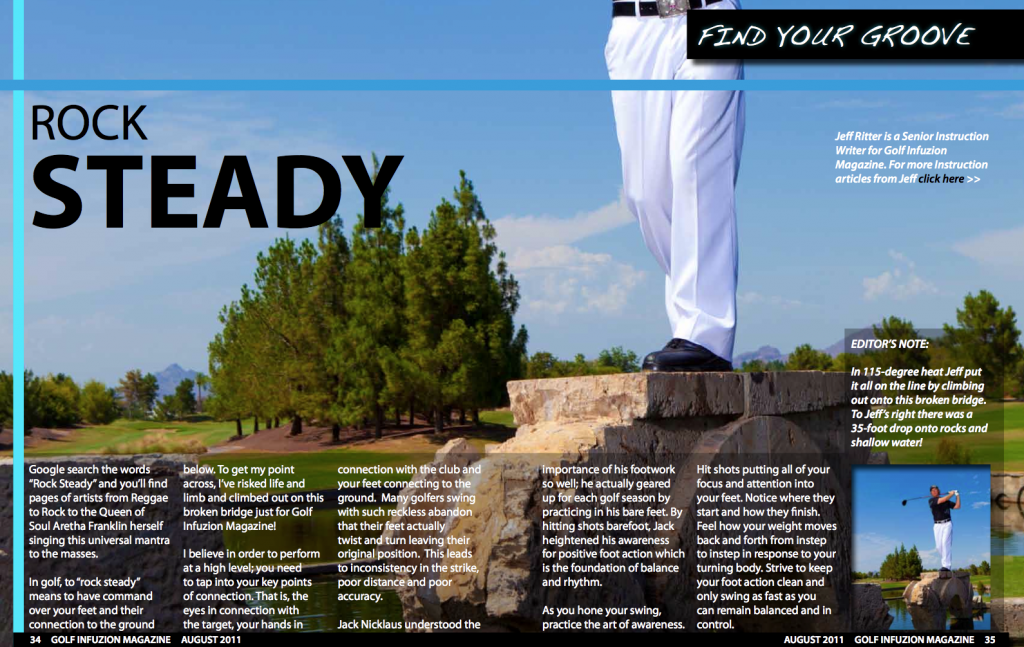
Rock Steady
Google search the words “Rock Steady” and you’ll find pages of artists from Reggae to Rock to the Queen of Soul Aretha Franklin herself singing this universal mantra to the masses.
In golf, to “rock steady” means to have command over your feet and their connection to the ground below. To get my point across, I’ve risked life and limb and climbed out on this broken bridge just for Golf Infuzion Magazine!
I believe in order to perform at a high level; you need to tap into your key points of connection. That is, the eyes in connection with the target, your hands in connection with the club and your feet connecting to the ground. Many golfers swing with such reckless abandon that their feet actually twist and turn leaving their original position. This leads to inconsistency in the strike, poor distance and poor accuracy.
Jack Nicklaus understood the importance of his footwork so well; he actually geared up for each golf season by practicing in his bare feet. By hitting shots barefoot, Jack heightened his awareness for positive foot action which is the foundation of balance and rhythm.
As you hone your swing, practice the art of awareness. Hit shots putting all of your focus and attention into your feet. Notice where they start and how they finish. Feel how your weight moves back and forth from instep to instep in response to your turning body. Strive to keep your foot action clean and only swing as fast as you can remain balanced and in control.
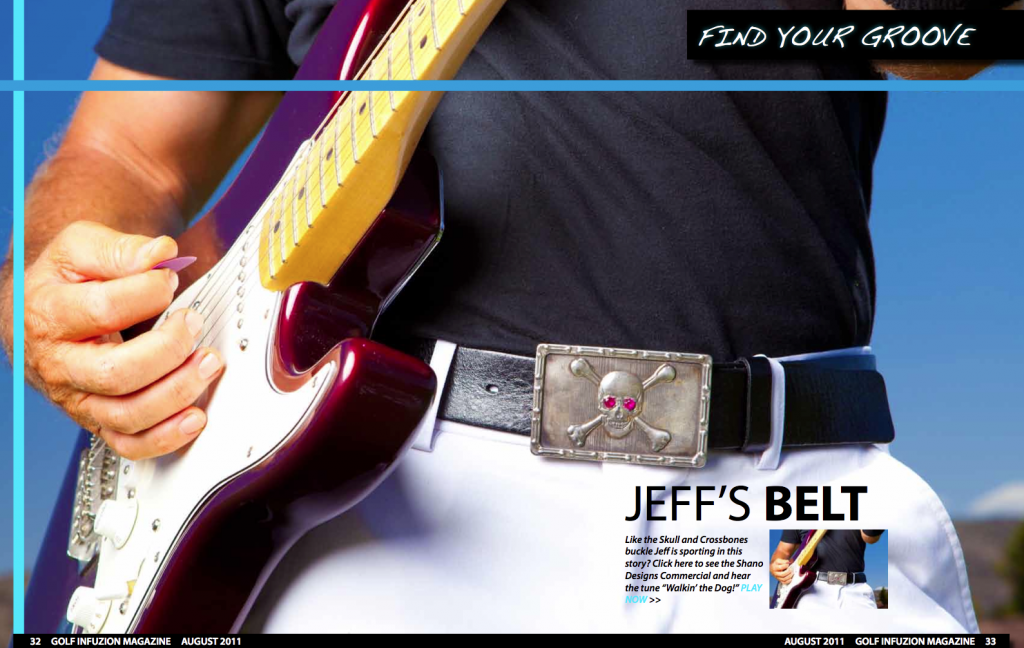
Like the Skull and Crossbones buckle Jeff is sporting in this story? Click here to see the Shano Designs Commercial and hear the tune “Walkin’ the Dog!”




